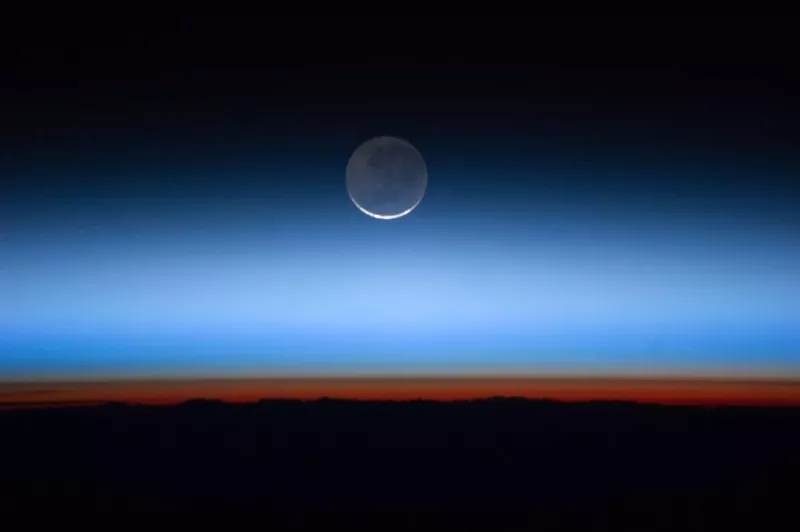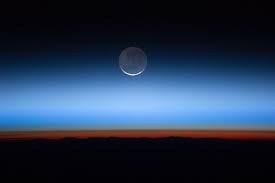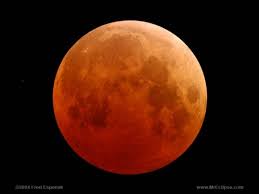View Other Topics.
 Oct 3, 2016
Oct 3, 2016
The Time and Date web site has the definitions of the exotic Moons we hear about but have no idea what they are. Black Moons, Blue Moons, Red Moons... all defined here.
What Is a Black Moon?

Black Moon - clipartkid.com
There are several definitions of Black Moon. It can be the third New Moon in an astronomical season with four New Moons or the second New Moon in the same calendar month.
The first days after a New Moon
Black Moon is not a well known term in the astronomy world. In recent years, the term has been made popular by astrologers and followers of the Wiccan religion.
No Single Definition
There is no single accepted definition of a Black Moon. The term has been commonly used to refer to any of the following phenomena associated with the New Moon:
Second New Moon in a calendar month: These Black Moons occur relatively often - once every 2.5 years.
3rd new moon in a season of 4 New Moons: Astronomers divide a year into 4 seasons - spring, summer, fall (autumn), and winter. Usually, each season has 3 months and 3 New Moons. When a season has 4 New Moons, the 3rd New Moon is called a Black Moon.
A calendar month without a New Moon: This can only happen in the month of February. When this occurs, January and March will have 2 New Moons, instead of the usual 1 New Moon
A calendar month without a Full Moon: About once every 19 years, the month of February does not have a Full Moon. Instead, January and March have 2 Full Moons each. The next Black Moon by this definition will occur in February 2018.
Ritual Significance
Black Moons hold special significance to people who practice certain forms of Pagan religions and who believe certain actions become more potent when performed on the night of a Black Moon.
Blue Moon

Full Blue Moon - clipartpanda
Blue Moon is a term used to describe similar combinations of Full Moons. It can either be the second Full Moon in the same calendar month or the 3rd Full Moon in an astronomical season of 4 Full Moons.
When Is the Next Blue Moon?
There are two definitions of a Blue Moon in astronomy; both are a type of Full Moon. If the moon actually looks blue, it's caused by a rare type of dust in the atmosphere.
The term 'once in a Blue Moon' means that that something is very rare. But just how rare, depends on your definition.
In astronomy, a Blue Moon is a Full Moon, which doesn't quite fit in with the months in our calendar. However, there are 2 completely different ways of calculating which Full Moon is a Blue Moon.
Blue Moon: The Full Explanation
2 Different Definitions
Blue Moon = The 3rd Full Moon in an astronomical season with 4 Full Moons
(versus the normal 3)
Blue Moon = The 2nd Full Moon in a month with 2 Full Moons.
Next Blue Moon (1) :
(3rd Full Moon in a season with 4)
Find Time & Date for Both
On our Moon Phase Pages, you'll find your local and worldwide times and dates for both of the Blue Moon definitions, along with Moon Phases and lunations, Super Moons, and Black Moons.
Defining the Original Blue Moon
The correct, original definition is that a Blue Moon is the 3rd Full Moon in an astronomical season with 4 Full Moons. A normal year has 4 astronomical seasons - spring, summer, fall (autumn), and winter - with 3 months and normally 3 Full Moons each.
When 1 of the astronomical seasons has 4 Full Moons, instead of the normal 3, the 3rd Full Moon is called a Blue Moon.
Next Blue Moon (2):
(2nd Full Moon in a month)
Blue Colored Moon

Atmospheric blue moon - NASA
Astronomical Blue Moons happen either once every 2 to 3 years or so, depending on which of the definitions you apply.
A Moon that actually looks blue, however, is a very rare sight. The Moon, full or any other phase, can appear blue when the atmosphere is filled with dust or smoke particles of a certain size; slightly wider than 0.7 micron. The particles scatter the red light, making the Moon appear blue in color. This can happen for instance after a dust storm, a forest fire, or a volcanic eruption.
Eruptions like on Mt. Krakatoa, Indonesia (1883), El Chichon, Mexico (1983), Mt. St. Helens (1980) and Mount Pinatubo (1991) are all known to have caused blue moons.
Are Red Moons Rare?

Red Moon - earthsky.com
Red Moons, which can be caused by other sizes of dust particles or by Total Lunar Eclipses, are much more common than Blue Moons.
Tags:
#astrology,#black#moon,#blue#moon,#atmospheric#blue#moon,#full#blue#moon,#nasa,#astrologers,#starzpsychics.com,#starz#psychics
Black & Blue Moons.

The Time and Date web site has the definitions of the exotic Moons we hear about but have no idea what they are. Black Moons, Blue Moons, Red Moons... all defined here.
What Is a Black Moon?
Black Moon - clipartkid.com
There are several definitions of Black Moon. It can be the third New Moon in an astronomical season with four New Moons or the second New Moon in the same calendar month.
The first days after a New Moon
Black Moon is not a well known term in the astronomy world. In recent years, the term has been made popular by astrologers and followers of the Wiccan religion.
No Single Definition
There is no single accepted definition of a Black Moon. The term has been commonly used to refer to any of the following phenomena associated with the New Moon:
Second New Moon in a calendar month: These Black Moons occur relatively often - once every 2.5 years.
3rd new moon in a season of 4 New Moons: Astronomers divide a year into 4 seasons - spring, summer, fall (autumn), and winter. Usually, each season has 3 months and 3 New Moons. When a season has 4 New Moons, the 3rd New Moon is called a Black Moon.
A calendar month without a New Moon: This can only happen in the month of February. When this occurs, January and March will have 2 New Moons, instead of the usual 1 New Moon
A calendar month without a Full Moon: About once every 19 years, the month of February does not have a Full Moon. Instead, January and March have 2 Full Moons each. The next Black Moon by this definition will occur in February 2018.
Ritual Significance
Black Moons hold special significance to people who practice certain forms of Pagan religions and who believe certain actions become more potent when performed on the night of a Black Moon.
Blue Moon
Full Blue Moon - clipartpanda
Blue Moon is a term used to describe similar combinations of Full Moons. It can either be the second Full Moon in the same calendar month or the 3rd Full Moon in an astronomical season of 4 Full Moons.
When Is the Next Blue Moon?
There are two definitions of a Blue Moon in astronomy; both are a type of Full Moon. If the moon actually looks blue, it's caused by a rare type of dust in the atmosphere.
The term 'once in a Blue Moon' means that that something is very rare. But just how rare, depends on your definition.
In astronomy, a Blue Moon is a Full Moon, which doesn't quite fit in with the months in our calendar. However, there are 2 completely different ways of calculating which Full Moon is a Blue Moon.
Blue Moon: The Full Explanation
2 Different Definitions
Blue Moon = The 3rd Full Moon in an astronomical season with 4 Full Moons
(versus the normal 3)
Blue Moon = The 2nd Full Moon in a month with 2 Full Moons.
Next Blue Moon (1) :
(3rd Full Moon in a season with 4)
- 18 May, 2019
- 22 August, 2021
- 19 August, 2024
Find Time & Date for Both
On our Moon Phase Pages, you'll find your local and worldwide times and dates for both of the Blue Moon definitions, along with Moon Phases and lunations, Super Moons, and Black Moons.
Defining the Original Blue Moon
The correct, original definition is that a Blue Moon is the 3rd Full Moon in an astronomical season with 4 Full Moons. A normal year has 4 astronomical seasons - spring, summer, fall (autumn), and winter - with 3 months and normally 3 Full Moons each.
When 1 of the astronomical seasons has 4 Full Moons, instead of the normal 3, the 3rd Full Moon is called a Blue Moon.
Next Blue Moon (2):
(2nd Full Moon in a month)
- 31 January, 2018
- 31 March, 2018
- 31 October, 2020
Blue Colored Moon
Atmospheric blue moon - NASA
Astronomical Blue Moons happen either once every 2 to 3 years or so, depending on which of the definitions you apply.
A Moon that actually looks blue, however, is a very rare sight. The Moon, full or any other phase, can appear blue when the atmosphere is filled with dust or smoke particles of a certain size; slightly wider than 0.7 micron. The particles scatter the red light, making the Moon appear blue in color. This can happen for instance after a dust storm, a forest fire, or a volcanic eruption.
Eruptions like on Mt. Krakatoa, Indonesia (1883), El Chichon, Mexico (1983), Mt. St. Helens (1980) and Mount Pinatubo (1991) are all known to have caused blue moons.
Are Red Moons Rare?
Red Moon - earthsky.com
Red Moons, which can be caused by other sizes of dust particles or by Total Lunar Eclipses, are much more common than Blue Moons.
Share this article with friends!
Tags:
#astrology,#black#moon,#blue#moon,#atmospheric#blue#moon,#full#blue#moon,#nasa,#astrologers,#starzpsychics.com,#starz#psychics






